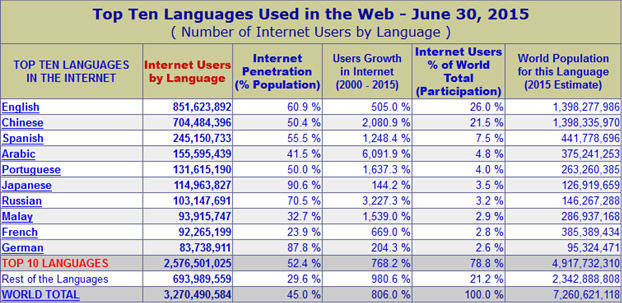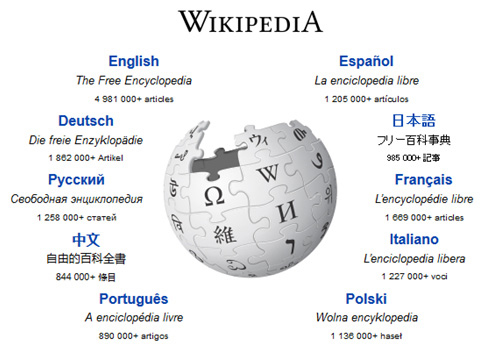Brief History of Localization
While translation is most likely as old as the first languages, the modern translation & localization industry is a product of the second half of the 20th century. Due to higher economic growth in parts of the world and decreasing cost of exporting goods, the need for communicating and selling to customers in new languages ballooned and quickly surpassed what an old-school translator armed only with a pen and a dictionary could achieve. Personal computers came to the rescue; first as better typewriters, then as better dictionaries, and with the arrival of internet and CAT (Computer-Aided Translation) tools in the 1990s - as devices indispensable in translation. That period of localization growth was between languages that represented major exporting and importing markets - mostly to and from English, which by then was quickly becoming the world’s lingua franca.
English was translated into French, Italian, German and Spanish (knows as FIGS), the most common languages of European trade. Soon, languages of other important global players rose in importance: Japan and South Korea in Asia, and the remainder of developed countries in Europe. After the fall of the iron curtain, languages of Central and Eastern Europe joined the privileged club and that was pretty much it until recently.
However, a big shift is taking place now. The traditional markets and their languages are becoming saturated when it comes to localization; the world’s developed economies are running out of steam, and all eyes are on regions where growth can still be found – the emerging markets.
Internet and Technology Penetration
For every person online, there are two who are not. By the end of the decade, everyone on Earth will be connected. #NewDigitalAge#NewDigitalAge
— Eric Schmidt (@ericschmidt) 12:20 PM - 13 Apr 2013
In a little more than a generation, the internet has grown from a nascent technology to a tool that is transforming how people, businesses, and governments communicate and engage every day. Its economic impact has been massive, making significant contributions to nations’ gross domestic product (GDP), toppling whole industries and fueling new ones. It has also generated societal change by connecting individuals and communities, providing access to information and education, and promoting greater transparency. However, not all countries have harnessed its benefits to the same degree.
The next one billion people are about to come online in the next five years and this is going to empower a huge number of people.
If you look at the spread of internet penetration over the recent decades it is clear that, while the developed world is approaching 100% penetration, it is not yet widely available in the emerging countries of Asia, Africa and Latin America.
According to a report by eMarketer, it is expected that there will be roughly 3 billion internet users by the end of 2015, over 40% of the entire world's population. Continent-wise, Europe has the highest proportion of people with internet access at 77.6%. At the other end of the scale, only 20% of people in Africa can currently get online. The report also states that the percentage of those in the developed world that can access the internet (82.2%) is more than double the percentage of those in developing countries (35.3%). About 75% of the offline population is concentrated in only 20 countries and in disproportionately rural, low income, elderly, illiterate, and female communities.
In the recent few decades, more people have been lifted out of poverty in emerging markets than at any point in world history. The same can be said for reduction in mortality, reduction of illness, and increase in literacy. While the digital divide in the world’s poorer regions is more persistent than previously thought, the next billion internet users will be added by 2020 according to latest estimates from The State of Broadband 2015 report by the United Nations.
Future internet users are likely to come from less well educated, less urban backgrounds and from a base in other languages and dialects.
— The State of Broadband 2015
According to McKinsey, approximately two billion people - or nearly half the offline population - reside in ten countries that face significant challenges in internet penetration. An additional 1.1 billion people live in countries in which a single barrier category dominates:
- High barriers across the board (550 million offline individuals): Bangladesh, Ethiopia, Nigeria, Pakistan, and Tanzania face entrenched obstacles to expanding Internet adoption.
- Medium to high barriers (1.4 billion): Egypt, India, Indonesia, the Philippines, and Thailand. This group had an aggregate Internet penetration rate of 19 percent in 2013.
- Medium barriers, greatest challenges in incentives (800 million offline): China, Sri Lanka, and Vietnam. The offline population in each country is largely rural and literate.
- Medium barriers, greatest challenges in low incomes and affordability (260 million): Brazil, Colombia, Mexico, South Africa, and Turkey.
- Low barriers across the board (180 million): Germany, Italy, Japan, Korea, Russia, and the United States.
For years, the computer industry has seen average system prices continuously decline around the globe, improving affordability and helping drive market growth. Nonetheless, computer penetration in emerging markets is still relatively low, but many in the industry believe that explosive growth will be unleashed once computer prices get low enough to enable the next one billion users to join the rest.
Emerging markets have been a fertile ground for innovative ideas that aim at taking computing to the masses, from inventive hardware solutions and new form factors to new business models. The world’s biggest hardware and software makers are racing to provide the solution to make this happen. Device makers like Xiaomi are pumping out low-price handsets in China and India, while Google and Facebook are working on solutions applicable anywhere in the developing world.
There are many people – billions of people, in fact – who still don’t have access to a smartphone, we want to change that
— Sundar Pichai, SVP of Android, Chrome & Apps for Google, 2014
Google has been working for several years on balloons that float in the stratosphere and function as aerial cell towers to provide internet access in areas with poor infrastructure, dubbed Project Loon. At the same time, it’s releasing Android ONE - affordable Android smartphones for poor developing countries. Until now people in developing regions have:
- been limited to feature phones with very limited or no mobile internet;
- not been able to enjoy the multifunctional benefits of modern smartphones;
- only been able to use SMS and voice calling;
- had no fixed-line broadband internet at home (or computer).
Google believes that ONE is the smartphone to win over customers in developing nations, and it is in the company’s own interest to get more people connected to the internet where they can be monetized at some point. Most Western users are already mobile internet connected, and the market is saturated. The growth area is the developing world.

Similarly, the Facebook-led Internet.org partnership with Samsung, Ericsson, MediaTek, Opera Software, Nokia and Qualcomm, launched in 2013 and renamed Free Basics in 2015, aims to expand global internet access. It offers a limited set of websites and apps free of charge to users in developing countries. In a move reminiscent of Google’s Project Loon, it is also betting on the skies to solve the connectivity problem. Earlier in 2015, the tech giant unveiled Aquila, the drone it hopes will deliver internet to the masses.
The next 1 billion consumers are going to come from these countries [outside the US and Canada]
— Carolyn Everson, VP of Global Marketing Solutions at Facebook, 2015
Where’s the Growth?
The story of the global economy since the end of World War II has gone something like this: capitalizing on better transport and communications technology, world production shifted en masse to poorer regions from rich countries like the United States. Factories replaced rice paddies in South Korea, China, Indonesia and elsewhere, which then shipped the mobile phones, computers and sneakers manufactured there to store shelves in the U.S. and Europe. The billions of people in these poorer nations couldn’t afford the products they made. But now, the global economy is rebalancing. Consumption in the U.S. and Europe is constrained by weaker job prospects and stagnant wages, while disposable income in China and other developing nations is increasing in leaps and bounds. That is making consumers in these countries the new engine of global economic growth. If the Western consumer dominated the 20th century, the emerging market consumer will control the 21st.
The emerging markets of the world have traditionally been shunned by international businesses due to their low purchasing power. While they remain far behind the developed world, their GDPs are growing at enviable rates along with their attractiveness to business. Emerging countries are easy to spot by the yellow and orange colors in the below map of per-capita GDP:
That map is nothing new, but let’s keep it in mind while we look at the rate of GDP growth:
It’s as if the colors have been inverted – the regions with lowest GDP often boast the highest growth.
There is also a boom in eCommerce (or mCommerce as it’s sometimes called, as so many transactions are carried out on mobile). China has recently surpassed the US as the world’s largest digital retail market and Asia is the most lucrative continent for mobile app sales. Taxi rides, movie tickets and fruit can be purchased through instant messaging apps, and this influence will only grow as millions upon millions of new users make their way online every month. You may think of the US as a wealthy nation, and Amazon as an online juggernaut, but Jeff Bezos’s online marketplace only shifted $110 billion worth of goods in 2013, while Chinese consumers spent a staggering $248 billion on Alibaba’s network of e-commerce sites in the same period. As Time writes: “Consumers in the developing world will rule the world”.
Even in revenue from computer gaming China has just surpassed USA for top spot, while Southeast Asia is growing faster than anywhere else. The overall Western European games market will reach $15.6 billion this year. While this represents a steady year-on-year increase of 1.9%, individual countries are losing their positions in the top 100 to the faster growing Southeast Asia, Latin America and Middle East and Africa.
Whereas developed countries are reaching saturation point, there’s huge potential for growth elsewhere, even when you factor in regional restrictions such as The Great Firewall of China. The massive populations of emerging markets are going online at a rapid pace and are able to afford more and more. But do they find content that’s localized for them?
Localize to Globalize

Growth in the languages available online for some of the main web-based services is not keeping pace with growth in overall internet usage.
— The State of Broadband 2015
Since it’s not possible to estimate the proportion of content in different languages in all types of media, let’s use the internet as a proxy. While for many readers of this article it may seem that the internet is still mainly an English sphere dominated by Western tech giants such as Google, Microsoft or Apple, the reality is quite different.
The internet developed from US Department of Defense’s ARPANET and English was the founding language of all technologies underpinning its invention and initial setup. As a result, most online content has been in English. Nowadays, the absolute domination of English is becoming a thing of the past.
Due to the huge number of websites, it is not easy to count precisely how many are in English and in other languages, but efforts have been made to estimate this. A 2009 UNESCO report monitored the languages of websites and found a steady year-on-year decline in the percentage of webpages in English from 75% in 1998 to 45% in 2005. Another effort by Internet World Stats shows the below comparison of internet users by language and rates of growth. Note that the growth of English-speaking users at 505% doesn’t look as impressive when compared to other languages:

Finally, Web Technology Surveys monitors one million most popular websites and publishes statistics about them. In October 2015, these were the top ten languages:

English shows a decline in all these reports.
Another method used to estimate the prevalence of languages online is looking at the different language versions of Wikipedia. At last count, it shows nearly five million articles in English, three or four times higher than the runner-up languages. Many other editions share the exponential growth of the English edition, though lagging one to three years behind. As these other Wikipedias grow, the overall percentage of articles in English is steadily decreasing.

Finally, we should not get caught in the Western-centric trap of assuming that content in other languages can only grow as new versions of existing English websites. Wikipedia, for example, has been blocked in China in the past and locally-grown equivalents have sprouted to fill in the gap, with Baidu Baike offering over 10 million entries already.
Change is in the air. The next one billion people who are going online are not going to be from the USA or Europe — they’ll be from the emerging nations of China, India, Southeast Asia, Africa and Latin America. That means traditional business strategies need to be rethought in light of how these new arrivals access the web and what they expect to find once then get online.
Localization as the Key to Growth

I thought what was necessary to connect everyone was new technology and a change in the economic structure. Instead, it’s all about content and awareness.
Brands based in the developed world need to do more than simply add new languages to the drop-down menus on their websites. To really connect with the emerging world, they need to understand the different approaches, cultures and contexts of the one billion new users making their way online, embrace a mobile-first approach, and adapt to infrastructure where high-speed broadband isn’t always guaranteed.
Social-networking sites are a major draw in developing markets, which stems in part from the ability of individuals to converse in their own language and share user-generated content that reflects local interests. However, developing nations often lack content — news stories, media, and eCommerce sites, and so forth — that reflect local information in local languages. While respondents in a survey by McKinsey believed that global providers offer the highest-quality content, they favored local ones because the information was in their local language and they could better understand it.
Much work remains to be done to spur the growth of local content in developing countries. In Africa, many nations lack content that local users find useful, though exceptions demonstrate that it can make a tangible impact on daily living. Local content categories that hold the highest value for consumers include social media, entertainment, weather, agriculture, utilities, e-government, and telemedicine, among others.
How to Localize for Emerging Markets

Over recent decades, localization processes, metrics and tools have evolved and standardized to the point where the languages may change, but in general the processes stay the same. In the 1990s, localizers became aware of the challenges of “double-byte” languages and Asian scripts, but the advent of Unicode solved many of these issues. Bidirectional languages such as Arabic have long been known to present special difficulties, but those peculiarities aside, the localization process is seen as a template to be applied to any language. The reality is that localization for emerging market languages does pose unique challenges.
CAT tool support is often missing or incomplete for these languages. Lack of technical language support, line-break, segmentation, expansion and font size problems and incompatibilities are very common in non-Latin scripts. Even for more established languages such as Chinese, there is little support for using them as a source. Unicode may exist, but is often not widely adopted due to lack of awareness, fonts or input methods.
Additionally, translators for these regions often don’t use CAT tools at all. A freelance edition may cost what is several months’ wages for an educated Indian office worker, and with the benefits of CAT tools accruing largely to the client, the flat model of CAT tool pricing fails in emerging markets. Add to this the fact that the less common languages naturally have far fewer professional translators and many of them work regular jobs. There tends to be a lack of translator associations and accreditations and even translation degrees may assume no working ability in English and begin with “English 101”.
There is often inconsistent terminology and a lack of standards. As an example, Microsoft tends to eschew loanwords and transliterations in favor of pure translations with the conviction that where they lead, others will follow. On the other hand, Oracle tends to survey what is being actually used by the minority of the educated population who use computers every day, so their glossaries are full of loanwords from English and transliterations. Both approaches are valid, but the outcome is that even the most basic IT terms may be translated differently across companies and end-users. When this is compounded by issues around dialect (such as North vs South Vietnamese) termbases tend to be much more problematic in emerging markets.
The above are practical localization issues that emerging market languages face, but there are also significant cultural/religious sensitivities. Most emerging markets score low on the Press Freedom Index, and are a minefield for companies that assume that the same approach that worked fine in Europe, Japan or Korea, will apply everywhere. Consider, for example, that YouTube was banned in Thailand several times in recent years because videos deemed offensive to the country’s revered monarch were posted online. The Thai government demanded they be removed before they made the service accessible again.
Problem or Opportunity?
Localization professionals in developed countries talk about certain emerging market languages as being problematic. Actually, it’s not that emerging market languages are problematic — it’s the assumption that all languages can be localized with the same process that is fundamentally flawed. Rather than assuming that if a process works for the first 15 languages, new languages should be shoehorned into the same process, localizers need to address the specific issues of emerging market languages, starting with an assumption that there will be technical and practical difficulties in these languages.
The time to think about localizing for the next one billion is now.











